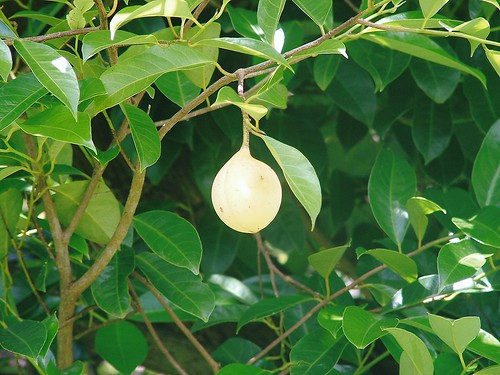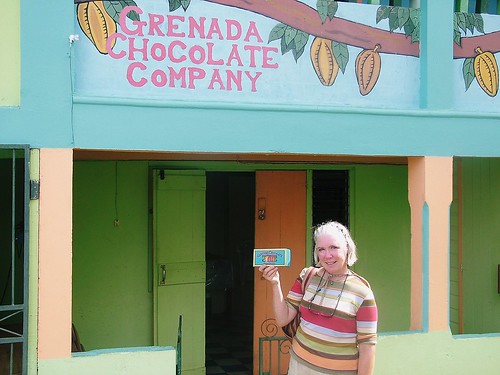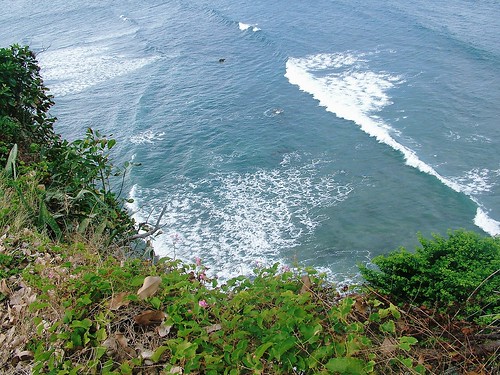Nutmeg tree, nutmeg factory, nutmeg icecream!

First the Nutmeg Tree. Here at "Spice Island", Grenada, we find "The Laura Herbs and Spice Garden. There is a sign on the main raad, then you guess your way to a box-like two-story building at road's end. Our young guide of the grounds knows each herb, bush and tree by heart, reciting quickly, all in one breath. We learn about cinnamon. They chop the whole tree down. The bark curls in the sun, and they remove it. It's the bark that is the cinnamon. Another tree grows right up from the tree stump. They can harvest again in eight years!
But it's the nutmeg tree that is Grenada.
NUTMEG: ALL YOU WANT TO KNOW!
So, let me tell you about the nutmeg. With just 10% of the trees left unscathed by "Ivan", they're harder to come by. They bear fruit, yellowish, apricot size. When ripe they split open and fall from the tree. The fruit is made into jellies, jam and syrup. yummmmmm.
The nut inside has an orange-red coat of mace around it. This is worth six times that of the nut and is collected and sold to the factory separately. Mace is dried, turns bright safran-yellow and is on a well-stocked spices shelf. And, bright in color, it is used in cosmetics, too. And mace is also the mace of riot-control.
Then there's the nutmeg stone. It's in a hard shell. After the nut is dried, the shell is cracked. Not discarded, it's used for walkways, mulch and as tinder for coal stoves. We walked on it up at some of the Grand Etang trails. Very bouncy!
Now we're inside the nut, at the kernel. Once the whole nuts are sorted, out of the crusher's jaws, they are immersed in water. The heavy ones sink. They're dense, class-one nuts. The lighter ones float. Not good, they're second rate. Nuts are sold whole or ground. Nutmeg is a great spice. What would egg-nog be without it! Rum Punch always has a dusting of nutmeg on it here. Also good, dusted with cinnamon and nutmeg, is strong new-brewed coffee. Spice cakes and muffins have nutmeg, but also spicey meat dishes.
It was at The Grenville Nutmeg Factory, a farmer's co-op, East Grenada, we learned the process from nut to nutmeg. The 17 workers there now were part of a 160-person workforce, pre "Ivan". The sacks piled up, 150 pounds of ready nutmeg, are all second grade. And there are no buyers for them. Half of the 17 workers here will be laid off nest week. And it'll take six to ten years before the new nutmeg trees bear enough fruit to start up again. The dusty wood trays for drying nuts in the warm Caribbean sea breezes are mostly empty. The machines are simple , but the labor intensive sorting has given lots of work to women here.
The next hurricane season starts in May. Cross your fingers and keep your head down!
The Grenada Chocolate Company is hard to find. It's by "Jenny's Whi
 m", near St.John's. After a road-sign we and another rental car climb a lonely,narrow concrete road forever up and into old plantation hills. No factory buildings in sight. But a lovely view of the ocean beyond the green hills. Back down to the sign.
m", near St.John's. After a road-sign we and another rental car climb a lonely,narrow concrete road forever up and into old plantation hills. No factory buildings in sight. But a lovely view of the ocean beyond the green hills. Back down to the sign.And there it is! A jolly multi-colored bungalow in a pleasant neighborhood. Just below the little balcony the identifying sign> The Grenada Chocolate Company", in a lime-green, lemon-yellow and orange design. How could we miss it?!
The enthusiastic chocolate factory man, let's call him Charlie, shows us the various machines, some rather antique, that make cocoa powder, cocoa butter and a really good chocolate bar. Two types, one 60%, and one 71% chocolate. From cocoa bean to hand-wrapped bar.The beans are dried and crushed, emulsified and mixed smoooooth. The wrapper is gorgeous, bright and cheery in the same Caribbean colors of the factory sign.
Souvenirs bought!
Next stop: "Carib's Leap". The Caribbean's history in a nutshell. They weren't the first Amer-indian tribe to come to the islands; but they were the most tenacious and the last to go.
It was the mostly peaceful Arawaks that arrived in the uninhabited islands only about 2000 years ago. Then, a thousand years later, the fierce, sometimes cannibal, Caribs disturbed their peace. They fought with fire and poison-tipped arrows and forced the Arawaks to flee. They had weapons for torture and took slaves. Atrocities have no racial boundaries, just ask an Arawak. But the Caribs also developed fine pottery and built swift, dug-out canoes. "Canoe" is a Carib word.
5oo years more passed. Then the Europeans came, with firearms. The various
 European nations continued their home rivaly and fought for new territories in the Caribbean, wiping out about all the Amer-indians in the process. Either by war, disease of attrition. The proud Caribs here, in 1651, leaped to their deaths rather than surrender to the French colonists.
European nations continued their home rivaly and fought for new territories in the Caribbean, wiping out about all the Amer-indians in the process. Either by war, disease of attrition. The proud Caribs here, in 1651, leaped to their deaths rather than surrender to the French colonists.The sign indicating the cliff is in the village of Sauteurs in the North. Behind it, a vertical drop into a frothy Atlantic ocean. You'll find the cliff at the far end of a neglected, but still used cemetary near the big Catholic church. Which seems to be undergoing extensive repairs, post-"Ivan".
One last stop: "The Nutmeg". A delightful restaurant in the Carenage, St. George's. We find a table on the pleasant veranda. Huge open windows give us a sea-breeze and a veiw of the inlet and the waterfront. Friendly and informal with a good menu. And we cap the meal with coffee and nutmeg ice cream. Of course.!

0 comments:
Post a Comment!
<< Hide